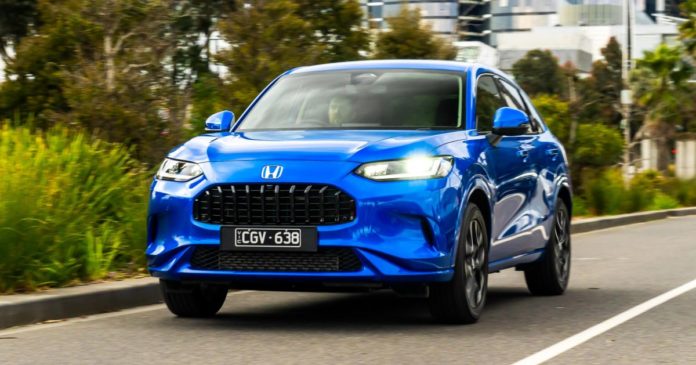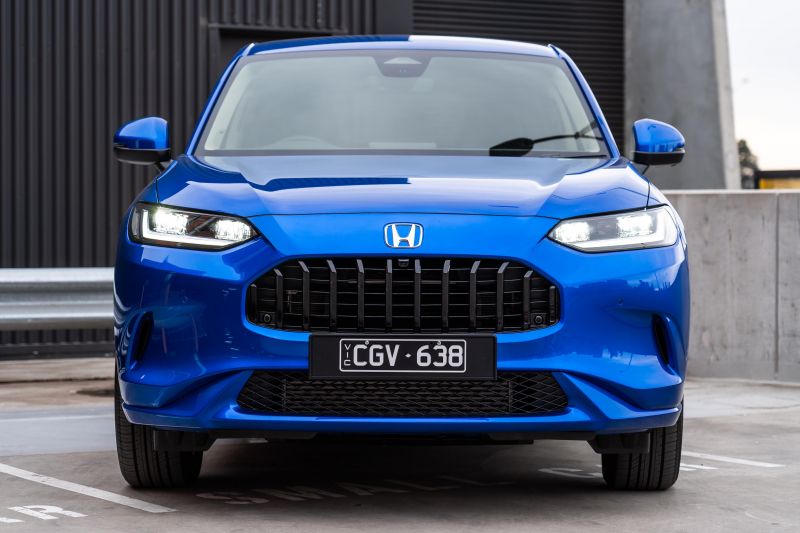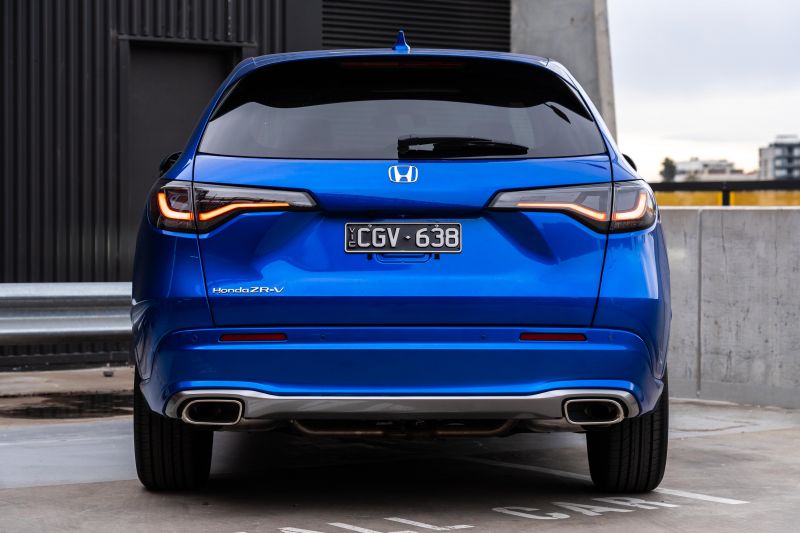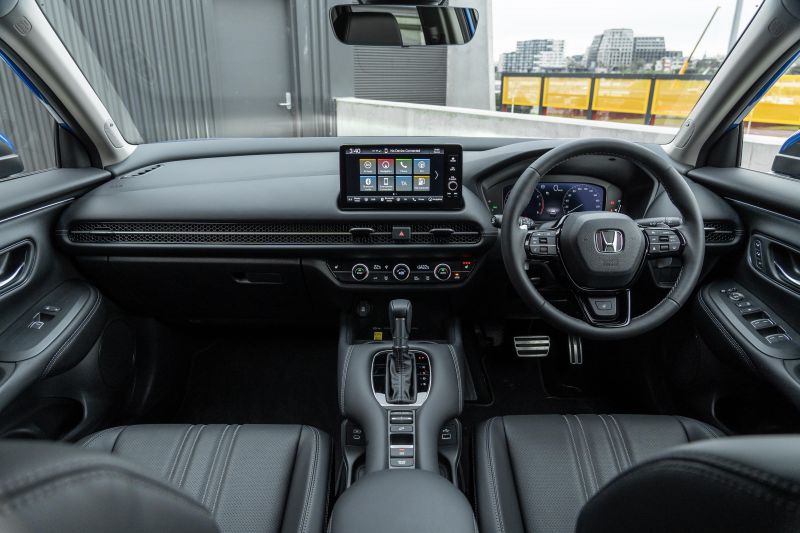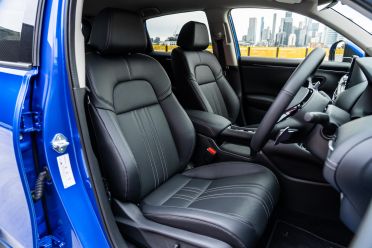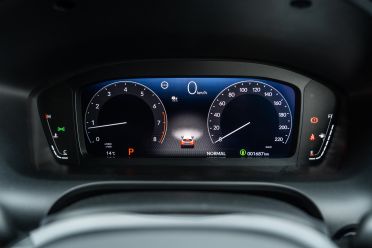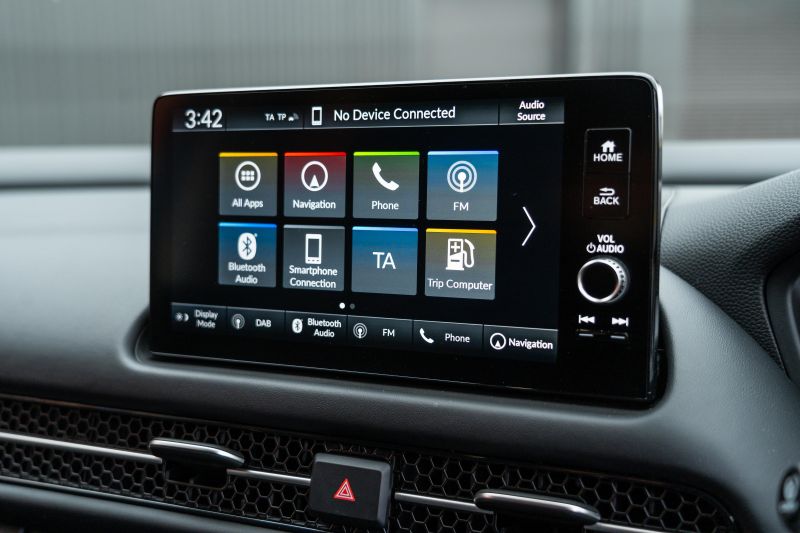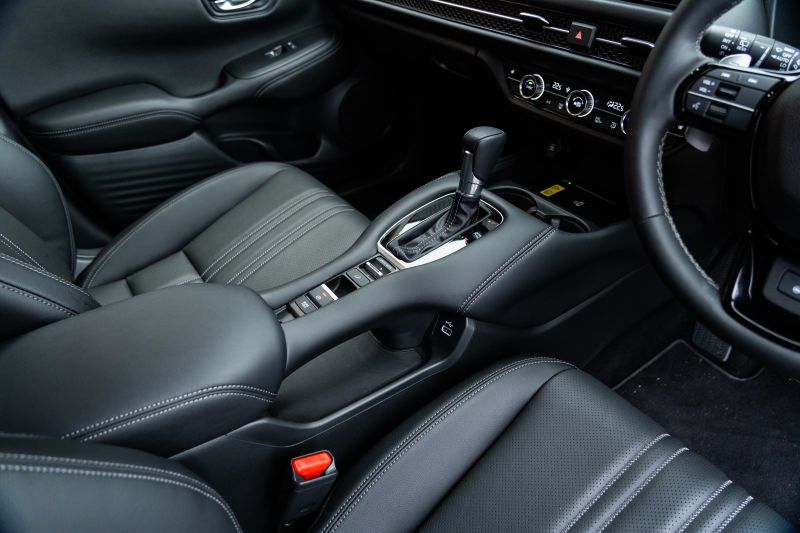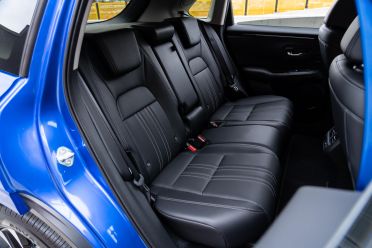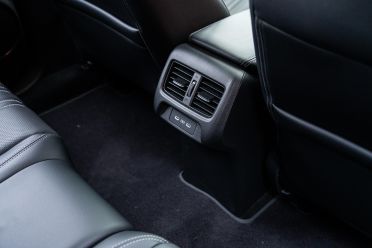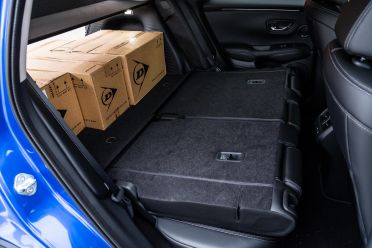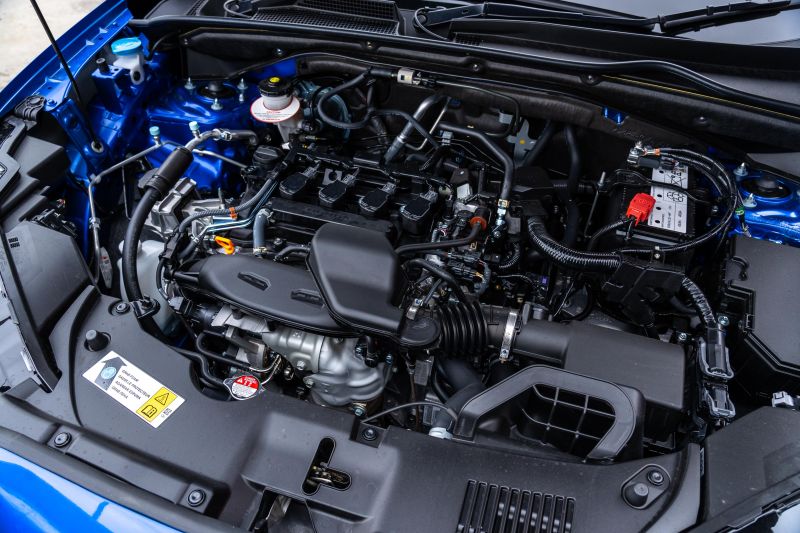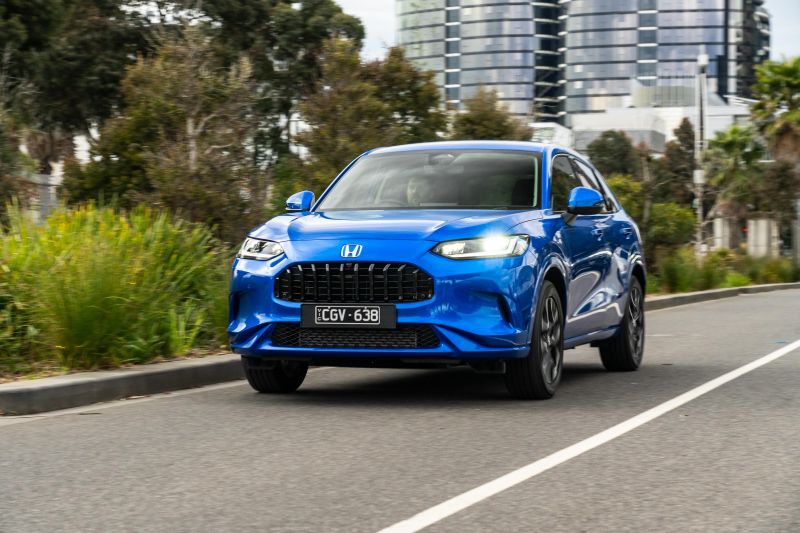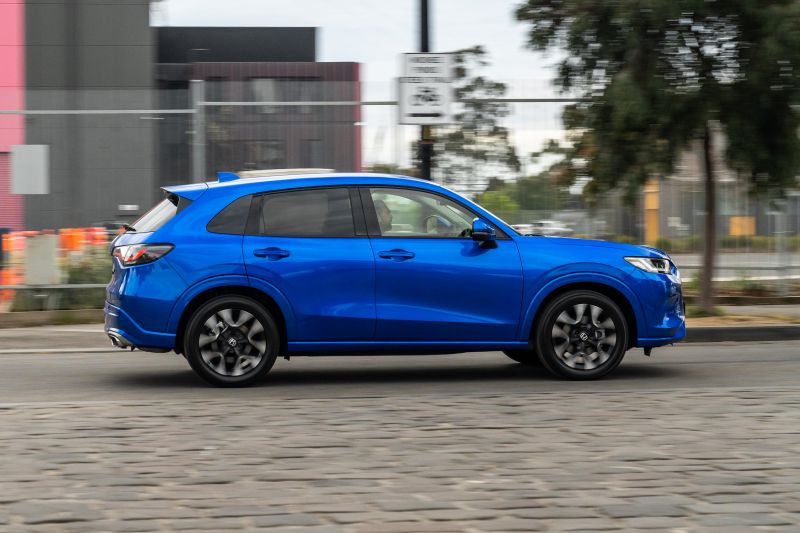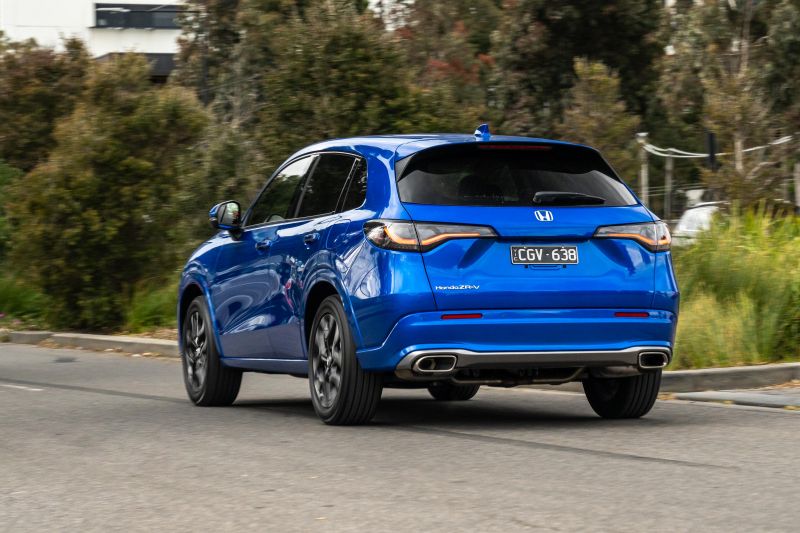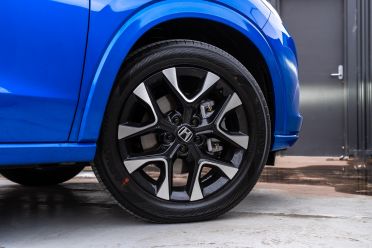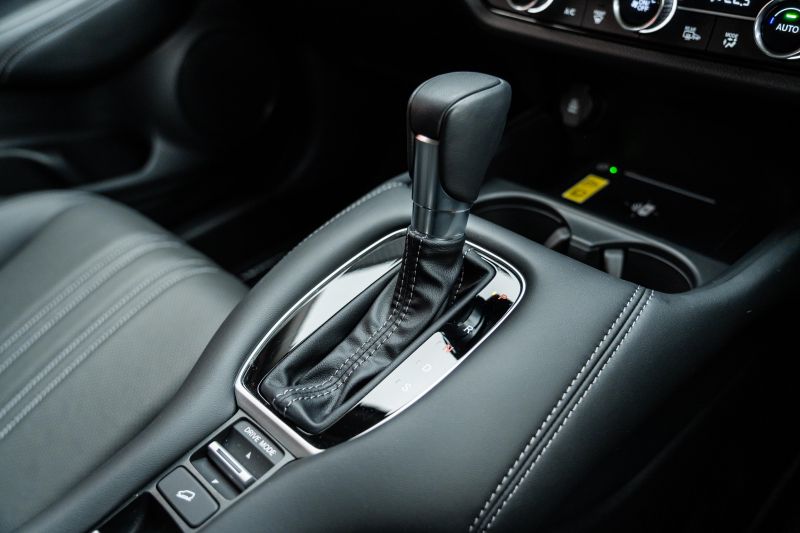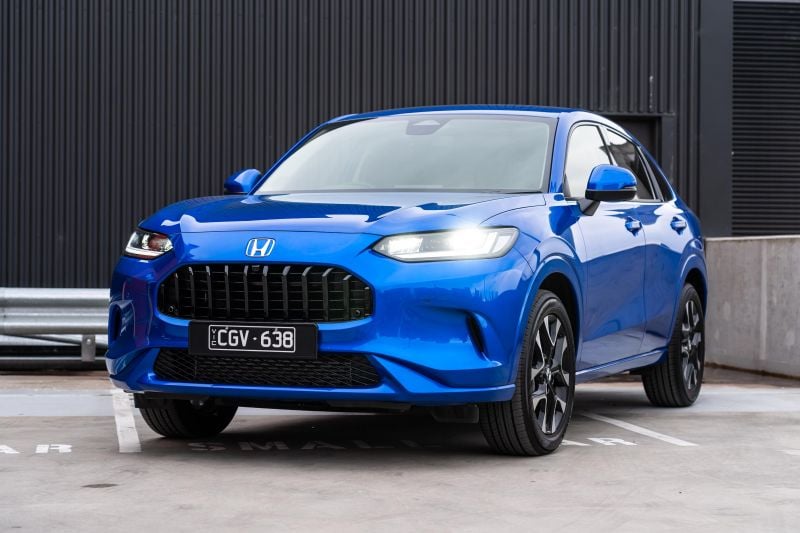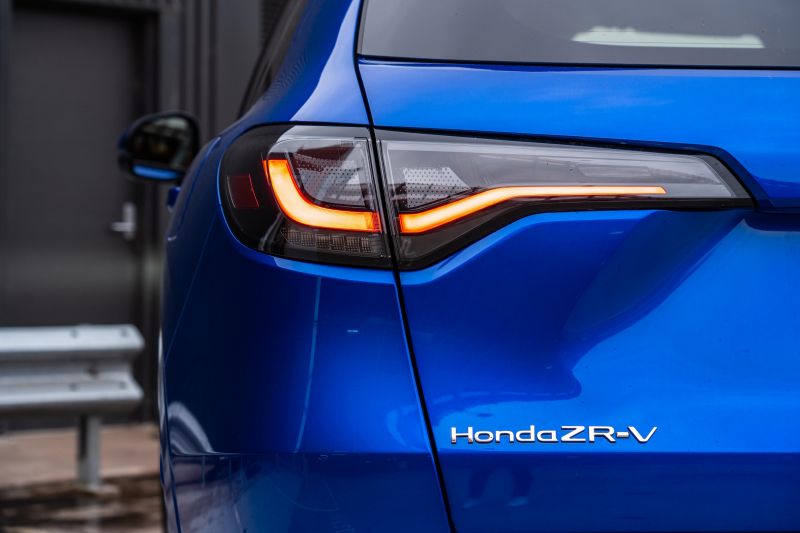My first car was a blue Honda – a first-generation CR-V Sport, to be exact.
At the time Honda was in its heyday, often touted as Japan’s rival to the Germans, renowned for high-quality, tech-laden and well-mannered vehicles.
I was left a little uninspired by the brand’s more recent offerings, namely the previous-generation Civic and CR-V. Where the Hondas of old were built like bank vaults with well-rounded dynamics, later cars have felt lacking in several areas – despite offering excellent handling and steering feel.
That’s all changing in front of our eyes. Honda has been busy reinventing itself and getting back to its roots, as proven by the excellent new Civic and HR-V. Now we have a new nameplate in the mix – the Honda ZR-V.
Slotting between the HR-V and CR-V, the ZR-V is effectively a Civic on stilts and pitches itself as a new sporty offering in the mid-size SUV segment – though it’s at the smaller end of the class like the top-selling Mazda CX-5.
But with no nameplate legacy, entering Australia’s hottest new vehicle segment is no easy task. Many will know Honda, but few will know what a ZR-V is.
On test we have the Honda ZR-V VTi LX, the most expensive petrol variant that seems like sharp value in today’s market at under $50,000 drive-away – is it a new top pick?
How much does the Honda ZR-V VTi LX cost?
The second-from-top ZR-V VTi LX is priced at $48,500 drive-away – Honda offers fixed drive-away national pricing.
It’s the most expensive turbo petrol-powered ZR-V variant in Australia, sitting $5300 above the mid-spec VTi L and $6400 below the top-spec e:HEV LX hybrid.
In the context of competitors, the ZR-V VTi LX sits in the same bracket as low- or mid-spec mid-size SUVs as well as high-spec small SUVs. Two key rivals are the aforementioned Mazda CX-5 and the Nissan Qashqai.
The Mazda can be had in G25 Touring AWD trim for just over $49,000 drive-away, while the Nissan Qashqai Ti is a little dearer than the Honda at $51,919 drive-away based on a Victorian postcode. You could also cross-shop the ZR-V with the Skoda Karoq (from $43,990 D/A).
Larger alternatives for similar money include the Hyundai Tucson Elite 1.6T AWD ($44,150), Kia Sportage SX+ 1.6T AWD ($43,850) and the Toyota RAV4 GXL 2WD Hybrid ($45,260).
Honda ZR-V pricing:
- Honda ZR-V VTi X: $40,200
- Honda ZR-V VTi L: $43,200
- Honda ZR-V VTi LX: $48,500
- Honda ZR-V e:HEV LX: $54,900
Prices are drive-away
What is the Honda ZR-V VTi LX like on the inside?
Like pretty much every other new Honda – and I’m not complaining.
The Japanese brand has a really strong identity with its latest range, meaning if you sit in a Civic, ZR-V, HR-V or new CR-V, you’re going to immediately feel a sense of familiarity.
Build quality and tactility is up there with some of the best, with heaps of soft-touch surfaces and padded, stitched leatherette extended trim accents. This is Honda’s new SUV flagship in Japan, and it feels it in here.
The VTi LX grade brings luxury features like powered and heated front seats, a heated steering wheel, embedded satellite navigation for the 9.0-inch touchscreen infotainment system, and a thumping 12-speaker Bose sound system.
We’ll get into features in a bit, but the range of powered adjustment for the driver and the comfortable front chairs mean you can find a good driving position easily easily and feel supported on longer drives. I will note the seats are fairly low which makes the ZR-V feel more car-like – something to consider if you’re after a more commanding SUV view out.
Ahead of the driver is a 10.25-inch digital instrument cluster which is standard across the ZR-V line-up. It’s nice and simple and has cute graphics and animations – the little virtual ZR-V mirrors your lights and indicators – but it doesn’t have the breadth of configurability of some rival displays.
The 9.0-inch touchscreen infotainment system gets navigation in this specification, bolstering the existing wireless Apple CarPlay and Android Auto. Unlike Honda’s older cars, which were running software that looked like Windows 98, the new system feels bespoke and is fully featured – right down to the factory navigation.
Response and load times are good, and the overall user interface is very clean and easy to use. Honda Connect is standard across the range, with a five-year complementary subscription included with purchase. It offers a range of services that are accessible via a smartphone app, incorporating convenience and safety functions.
Highlights include:
- Remote functions
- Climate control pre-conditioning
- Lights on/off
- Remote lock/lock
- Automatic collision detection
- Speed Alert
- Vehicle status
- Emergency call
- Virtual dashboard
- Location finder
- Trip log
- Geofence alert
- Push notifications and messages
Storage up front is up there with the best in the class, with a slew of smart solutions to stow your things.
The bridge-type centre console has a little cubby under the electric park brake, and the shelf ahead of the shifter has a wireless phone charger pad.
Big bins in the doors can accommodate larger bottles, and there’s a cubby under the front-centre armrest that’s also handy for hiding things out of sight.
I’m also a big fan of the solid, clicky feel of all the switchgear and dials, which feels really high end. In particular, the knurled climate control knobs are a tactile delight, and remind me of Audi units.
The rear seat is pretty good, which is expected given this shares its DNA with the Civic hatchback. While not as outright capacious as much larger rivals like the Mitsubishi Outlander and Nissan X-Trail, the ZR-V offers good head, knee and leg room for taller occupants – like me at 6’1 – even behind my own driving position.
Two adults will be more than happy back there, while the skinny centre seat means a third occupant will be a little short changed. At least there’s an almost flat floor in the year which frees up more foot and toe room.
Further, the middle seat also gets a ceiling-mounted seatbelt which seems a little old-hat for a new car in 2023. The outboard seats also have ISOFIX anchors, while all three rear positions have top-tether points.
Amenities in the rear include directional air vents behind the console, map pockets behind the front seats, bottle holders in the doors, as well as a fold-down centre armrest with cupholders.
Perhaps the ZR-V’s only real drawback against competitors in the segment is its below-average luggage capacity, which at 370 litres (VDA) in VTi LX specification is down on even something like the Mazda CX-5 (438L). Note, VTi X and VTi L grades score 10L extra.
Drop the seats down and you get 1302L-1312L (VTi LX-VTi X/L), which is more substantial and competitive with rivals. Further, the already wide and square space is bolstered by a well-designed flat load bay – though no Magic Seats, for those asking.
Petrol (VTi) versions of the ZR-V all come with a 17-inch space saver spare wheel, compared to the e:HEV hybrid’s tyre repair kit.
What’s under the bonnet?
Petrol versions of the Honda ZR-V are powered by a 1.5-litre turbocharged four-cylinder petrol engine.
Shared with the Civic, the VTEC Turbo unit produces 131kW (6000rpm) and 240Nm (1700-4500rpm), with all versions in Australia sending drive to the front wheels via a CVT automatic with paddles – AWD is available overseas in markets like Japan.
Honda quotes combined fuel consumption of 7.2 litres per 100km in this specification, with CO2 emissions rated at 175g/km. Despite being homologated to Euro 6b emissions standards, local ZR-V models miss out on idle stop/start.
The ZR-V can take 91 RON regular unleaded fuel in its 57-litre fuel tank.
How does the Honda ZR-V VTi LX drive?
Like a Civic SUV.
With turbo power and a CVT automatic, the ZR-V has plenty of pep for everyday driving, and is deceptively quick in a straight line for the class.
It doesn’t quite feel as tight and tied down as its hatchback sibling, appearing to focus instead more on everyday comfort and refinement, and for the most part it really delivers.
The driver controls are responsive and accurate, inspiring confidence whether you’re pottering around town or cruising on the freeway, and the hunkered-down stance really helps that feeling of security at high speeds.
Driven sedately in town, progress is effortless and there’s little intrusion of engine noise into the cabin compared to rev-happy naturally-aspirated competition. Honda’s CVT doesn’t really simulate the ‘steps’ of a conventional automatic unless you’re going full throttle, so it can sound a little slurry or droney in normal driving.
Even on its bigger wheels compared to the entry VTi X variant, the ZR-V rides with aplomb. There’s good suspension travel to iron out the lumps and bumps of city streets, and the body is well controlled through successive undulations.
There’s a slight slapping feel over sharper hits, but it’s far from unrefined or unresolved. I was very impressed with the ride, which doesn’t really sacrifice handling capability. There’s a bit more body roll than the Civic given its softer tune and raised ride height, but the ZR-V is definitely more adept at taking a corner than something like an X-Trail.
Road noise remains a weaker spot for most Hondas, though the latest cars have definitely improved over previous generations. Tyre roar is present but not overbearing on coarse roads, and driven back-to-back with a Mazda CX-5 G25 Maxx Sport as well as the ZR-V VTi X the week prior, the LX felt noisier with its 225/55 Yokohama Advan tyres.
Wind noise, meanwhile is well suppressed – no doubt helped by the ZR-V’s slinky profile and skinny mirrors relative to some other mid-size SUVs.
The ZR-V is also fully equipped with Honda Sensing assistance technologies pretty much across the line-up.
Adaptive cruise control with ‘Low Speed Follow’ and an active lane centring function facilitate semi-autonomous highway driving; though as I’ve found with Hondas in the past it can be a little too conservative with vehicles entering your lane ahead and it shadow braked a few times without warning which was quite frustrating.
It’s otherwise well sorted in traffic jams, and the lane centring function didn’t feel like it was wrestling the wheel out of my hands. Proper blind-spot monitoring and rear cross-traffic alert are also pluses, as I was not a fan of Honda’s undercooked LaneWatch camera system.
I do lament the lack of idle stop-start tech, however, which leaves the ZR-V idling and sipping away in traffic. It meant that, unlike the Civic, fuel consumption ballooned around town into the 9.0s and nearly 10L per 100km – more on real-world consumption further down.
What do you get?
ZR-V VTi X highlights:
- Adaptive LED headlights
- Active cornering lights
- 17-inch alloy wheels
- Rain-sensing wipers
- Hill descent control
- 9.0-inch touchscreen infotainment system
- Wireless Apple CarPlay
- Wired Android Auto
- 10.2-inch digital instrument cluster
- 8-speaker sound system
- Black fabric upholstery
- Dual-zone climate control
- Auto-dimming rear-view mirror
- Leather-wrapped steering wheel and shifter
- Upholstered centre console with French stitching
- Front USB ports (1 x USB-A and 1 x USB-C)
- Rear USB ports (2 x USB-C)
- Rear air vents
- Space-saver spare wheel
- 60/40 split/fold rear seats
ZR-V VTi L adds:
- 18-inch alloy wheels
- Heated exterior mirrors
- Hands-free power tailgate incl. walk-away closing
- Rear privacy glass
- Combination LED tail lights
- Black leatherette upholstery
- Heated front seats
- Metal paddle shifters
- LED ambient lighting (roof)
ZR-V VTi LX adds:
- 18-inch two-tone alloy wheels
- Body-coloured lower bumpers, wheel arches
- Selectable drive modes (Sport, Normal, Economy)
- 12-speaker Bose sound system
- Wireless phone charger
- Satellite navigation
- Black leather upholstery
- 8-way power driver’s seat with memory
- 4-way power passenger seat
- Heated rear seats
- Heated steering wheel
- Sports pedals
- ‘Door Line Illumination’
- Auto-tilting mirrors in reverse
- Plasmacluster air purification system
Is the Honda ZR-V VTi LX safe?
ANCAP hasn’t tested the ZR-V yet, and therefore the Honda SUV remains unrated for now.
Standard safety equipment includes:
- 11 airbags
- Centre airbag
- Front and rear side airbags
- Full-length curtain airbags
- AEB incl. Pedestrian, Cyclist detection
- Adaptive cruise control with low-speed follow
- Driver attention monitoring
- Lane departure warning
- Lane keep assist
- Parking sensors front, rear
- Road Departure Mitigation
- Traffic Jam Assist
- Traffic sign recognition
- Tyre pressure monitoring
ZR-V VTi LX adds:
- Blind-spot monitoring
- Rear cross-traffic alert
- 360-degree cameras
How much does the Honda ZR-V VTi LX cost to run?
Like the wider Honda line-up, the ZR-V is covered by a five-year, unlimited-kilometre warranty. Hybrids also get an eight-year warranty for the high-voltage battery, and there’s 24/7 roadside assist across the board.
Honda also offers five years of free satellite navigation map updates when you service at a Honda Centre. Scheduled maintenance is required every 12 months or 10,000 kilometres – whichever comes first. Honda is currently capping scheduled maintenance at $199 per visit for the first five scheduled services for new models.
Real-world fuel consumption proved disappointing, with the ZR-V unable to get below 8.0L/100km during our week of testing despite plenty of highway driving thrown in.
Unlike the new Civic, the ZR-V lacks stop-start meaning consumption balloons once you hit heavy traffic. Given a portion of my daily commute to and from the CarExpert Melbourne office includes stop-start driving in heavy traffic, any drop in average consumption from my 15km-ish freeway stint was quickly offset.
I finished the week with an indicated 8.1L/100km showing in the trip computer, with some extra highway stints thrown in over the weekend. During the week I was seeing over 9.0L/100km, which would have me recommending the e:HEV if you plan to drive the ZR-V to and from work and want to minimise fuel costs.
CarExpert’s Take on the Honda ZR-V VTi LX
There’s a lot to like about the ZR-V, but for me there’s a red mark from me if you plan to mainly do urban driving.
For a new vehicle launched in the heavily electrified age, it seems like an oversight Honda has taken out fuel saving technology in what will likely be an urban-focused vehicle, especially since the hybrid is limited to the highest trim level at a substantially higher price point.
The ZR-V was too thirsty for my liking in real-world conditions, even more so than the comparatively ancient Mazda CX-5 G25 we had at the same time (comparison coming soon). It leaves me recommending the top-spec e:HEV as my pick of the range, though its lofty $55,000 price point and increasing wait times could have it out of reach for some buyers.
Otherwise, the ZR-V is a well-featured, well-priced and well-mannered crossover that should have wide appeal given the vehicles its up against, while its distinctive looks and bright colour options should help it stand out from the pack.
It has a nicely finished and well-packaged interior, if lacking a little in luggage capacity with five seats in use; it’s also nice to drive and has a bit of athletic DNA from the Civic without really sacrificing the comfort required of an SUV aimed at families.
The ZR-V is also pretty strong value for money, with this VTi LX grade getting pretty much everything you want for $50,000 bar a sunroof – which oddly isn’t available on any ZR-V at all. Perhaps the VTi L is the value pick of the range given its $5200 cheaper price point, and it doesn’t really sacrifice on the necessities.
All told, if you’re looking at a small to medium SUV that’s a little different and nice to drive, the Honda ZR-V is definitely worth a look.
Click the images for the full gallery
BUY: Honda ZR-V
MORE: Everything Honda ZR-V

